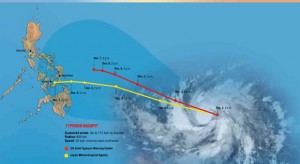
According to the Department of Budget and Management, the budgetary support would be drawn from the agencies’ respective quick response funds (QRFs).
The six government agencies that had been provided QRFs in preparation for the possible entry of Hagupit were the Departments of Agriculture (P406 million), Education (P564 million), Health (P500 million), National Defense (P448 million, on top of P764 million for the Office of Civil Defense), Social Welfare and Development (P1.01 billion), and Transportation and Communications (P1 billion).
“The departments are equipped with QRFs, standby funds that they can readily access when emergencies or disasters occur. They can use these funds to mobilize the necessary resources and manpower to extend relief and immediate assistance to victims,” Budget Secretary Florencio B. Abad said in a press statement on Wednesday.
“Because the QRFs are comprehensively released to the departments at the start of the year… the departments have the capability to perform emergency response functions without the need to fulfill required conditions and processes that may take time during a disaster,” he added.
In case Hagupit enters the country, the national government can source funding from the 2014 National Disaster Risk Reduction and Management Fund (NDRRMF) for post-typhoon response and rehabilitation.
“Given our country’s location along the typhoon belt in the Pacific, the national government knows it must prepare for any calamity. But we cannot predict the future. That’s why it’s essential that our national budgets have special purpose funds like the QRFs and the NDRRMF to address any contingency,” Abad said.
According to forecasts, Hagupit could make its way into the Philippine area of responsibility by Thursday, and would then be given the local name “Ruby.”
RELATED STORIES
Pagasa: 60% chance ‘Hagupit’ will make landfall in Eastern Visayas
‘Yolanda’-like ‘Ruby’ heads for PH